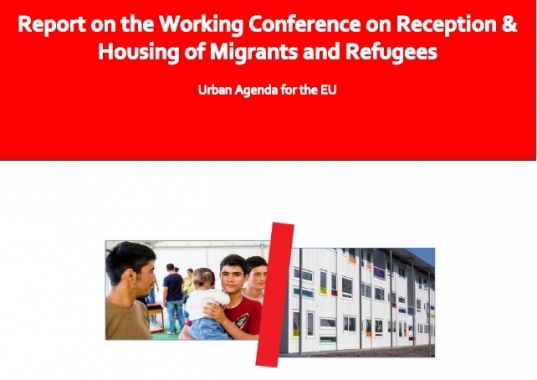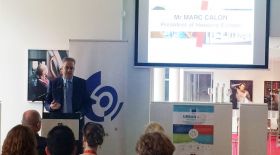Reception and Housing of Migrants and Refugees
Report from the EU Urban Agenda Workshop
Amsterdam, 16 February 2017 | Published in Social
Following the working conference on ‘Reception and Housing of Migrants and Refugees’ that took place the 10th- 11th of November 2016 the city of Amsterdam just published the report on the results. The recommended methods include many of our suggestions that we communicated through our scoping paper and through our active participation at the conference. Housing Europe had prepared a policy briefing that triggered the exchange between partners, while our President, Marc Calon held a presentation during the event.
The Working Conference aimed to come up with responses to the challenges outlined in the Scoping Papers by Housing Europe and Migration Policy Group concerning Reception and Housing and it brought together about 100 participants with an expertise in these fields, coming from both academic and professional backgrounds.
The scoping paper drafted by Housing Europe identified the so-called ‘bottleneck areas’. Based on these areas and the inputs from the conference, a number of actions and recommendations have been selected that have been grouped under EU funding, EU regulations, and EU Knowledge exchange.
The report contains several of Housing Europe’s recommendations:
- Reduce funding bariers and provide support with application and reporting
Method: It is proposed that these actors take up funding with the involvement of local authorities. It is further preferred that funds can be directly applied for at EU level. In addition, a helpdesk/one-shop stop can be set up to provide EU level assistance to actors who are in need of that.
- Combine existing EU funding programs with EIB loans to give cities direct access to funding
It is suggested to make part of the AMIF fund resources available to cities or enterprises directly in relation to expenditures concerning refugee inclusion. At present, AMIF funding is channelled through central governments. An opportunity for more direct access by cities or enterprises would be a ‘blending facility’ between the AMIF grant resources and EIB loan resources, under which AMIF grants could be combined with EIB loans to cities or social impact funds. In the case of such blending facilities - which are administered by EIB - the EIB enters into a direct relationship with the city or fund, rather than channelling the funds via central government.
- Relax rules on building renovation and transformation
Solutions are found in the renovation or transformation of old (vacant) building/offices. However, it can take a long time to obtain permits for such actions. In some cases this can be traced back to EU requirements concerning biodiversity and environment (that do not sufficiently take into account the need to act quickly in times of crises).
Method: Consider a fast track decision procedure for a (possible) relaxation of such rules and regulations.
- Peer to peer learning networks
Method: To make available a knowledge exchange programme for professionals in the field. This can be tied to existing exchange networks (URBACT, INTERERG, ERASMUS+) by making special calls in relation to migrants and refugees. Knowledge exchange networks should stimulate peerto- peer learning on (alternative) financing and provide (peer-) assistance in writing proposals.
- A Covenant of Mayors
Method: Set up a Covenant of Mayors on the inclusion of refugees and migrants. This can be done based on the rules of the existing Covenant of Mayors for climate and energy, an initiative of the European Commission in partnership with the Committee of Regions. Following that particular form, the Covenant of Mayors is a bottom-up movement that can mobilise a great number of local and regional authorities to develop action plans and direct investments towards the inclusion of migrants and refugees. The Covenant is not only for big cities, but also for smaller cities and towns, as well as regions as a whole. Furthermore, the Covenant’s website acts as a network portal and support structure for participating cities and citizens alike.
- Create a database for best practices
Method: Create or improve an (existing) EU database that allows the sharing of best practices on different issues, including reception, housing and integration. Existing knowledge tools/institutes/platforms such as the European Website on Integration, Europa Decentraal, Housing Europa, and EUKN etc. should be involved. A monthly newsletter (by topic) should further ensure dissemination.
Other recommendations include
Read More- Redistribute EIB financing to build housing
Method: It is suggested that governments use an EIB loan based on ‘Disasters Reconstruction’ to build new housing for refugees. This (re)construction takes place while refugees wait for status recognition. After status recognition has been received, refugees repay these loans via their rental costs. This payment of rent is in turn financed by ‘Refugee Aid’ funding. Put differently, the status holders pay off the EIB loan by means of another government subsidy. The repayment will approximately take 3 to 5 years. Thus, the key here is to enable local governments to redistribute EU funding to individuals.
- Relax state aid rules and public procurement
Method: It is suggested that EU rules become more flexible, mainly in terms of interpretation of exceptions in times of a crisis. The exceptions should be made in the EU sphere of competition and internal market for certain forms of housing for refugees. (Emergency) accommodation such as tiny houses, modular housing, containers, laneway housing etc. should be subject to more lenient rules on state aid and public procurement.
- Link housing to employment
The EU should foster a better relationship between employment services and social housing providers to achieve more effective labour market integration.
- Urban regulation impact assessment
Ideally, EU legislation should take into account and reflect urban knowledge and practices.
Method: In order to make this happen it is suggested to use an urban impact assessment for assessing EU regulation ex post and ex ante. It is thus proposed to enlarge the existing instrument of economic, social, and ecological impact assessment with a territorial -especially urban- dimension.
